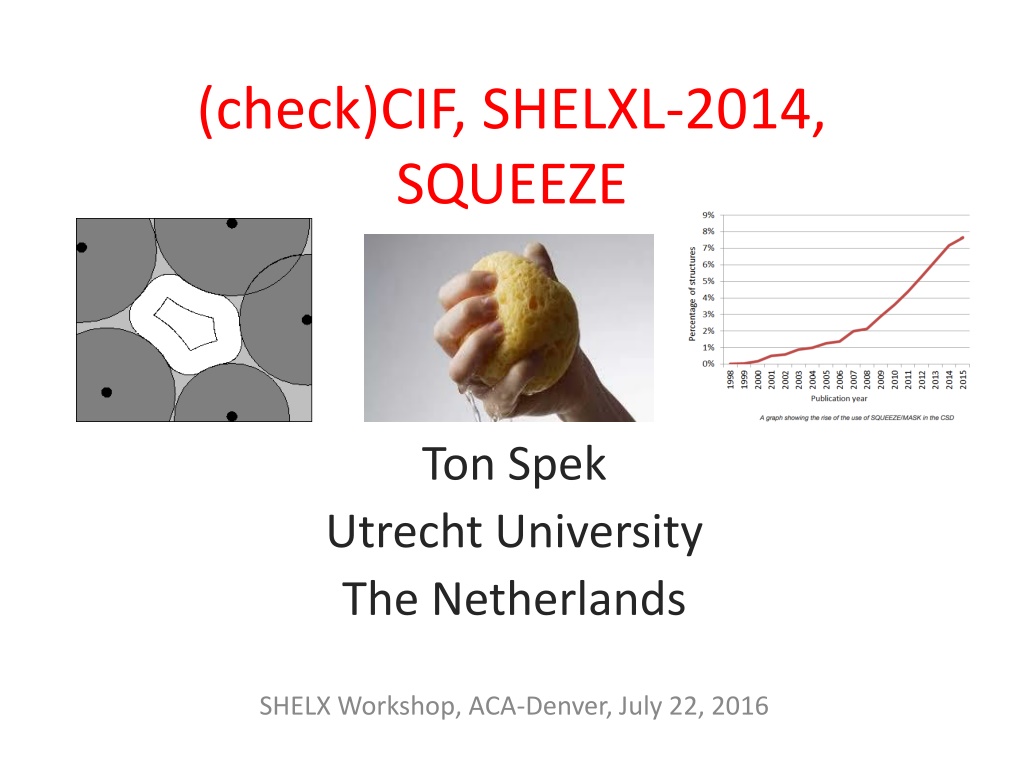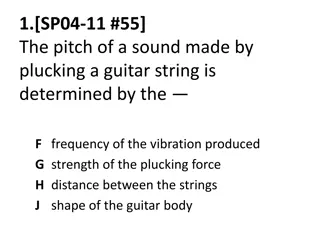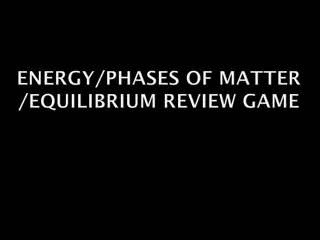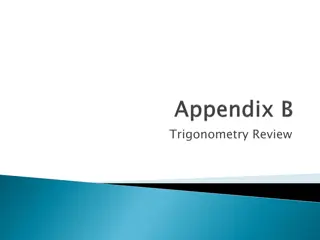Understanding CIF and SHELXL-2014: Key Concepts Explained
CIF (Crystallographic Information Framework) and SHELXL-2014 play vital roles in data exchange and archival for crystallography. The CIF standard, along with FCF validation, ensures accuracy in structural data publication. Learn about embedding experimental data, refinement instructions, and the ABIN instruction in SHELXL2014 for crystallographic analysis and interpretation.
Download Presentation

Please find below an Image/Link to download the presentation.
The content on the website is provided AS IS for your information and personal use only. It may not be sold, licensed, or shared on other websites without obtaining consent from the author. Download presentation by click this link. If you encounter any issues during the download, it is possible that the publisher has removed the file from their server.
E N D
Presentation Transcript
(check)CIF, SHELXL-2014, SQUEEZE Ton Spek Utrecht University The Netherlands SHELX Workshop, ACA-Denver, July 22, 2016
The CIF Standard & Validation CIF was created around 1990 by an IUCr committee for data exchange and archival. One of the early adopters was SHELXL97. Acta Cryst. C pioneered its use for publication data and text entry. Acta Cryst. C pioneered automated checking of data consistency and data completeness. Today, an IUCr-checkCIF report is an essential requirement for publication in most journals.
FCF-Validation Added A SHELX97 style CIF only reports the numerical results of a structure determination (i.e. Space group, model parameters and R-values) The associated CIF-style FCF file allows for a detailed analysis of the fit of the structure model (Fcalc) to the reflection data (Fobs) Together, the CIF + FCF offer the authors interpretation of the experimental data
Archival of the Experimental Data For a proper review and archival for possible follow-up research we would need at least the deposition of the unmerged reflection data. Needed to resolve issues concerning missed symmetry, missed twinning, hydrogen atoms, main molecule disorder, disordered solvents etc. The embedding mechanism was choosen to include the unmerged reflection data in the CIF as a comment with a proper data name, to be ignored in most applications such as graphics and geometry calculations.
Final .res & .hkl Embedding Two general data names were introduced for the inclusion of the refinement and reflection details _iucr_refine_instructions_details and _iucr_refine_reflections_details resp. The .res and .hkl are embedded as text between semicolons (i.e. ; <newline> <text> <newline> ; ) SHELXL2014 introduced its own equivalents: _shelx_res_file & _shelx_hkl_file along with associated checksums for data integrity. Those embedded data should NOT be edited or removed from the CIF. Use shredcif or PLATON to extract the .res & .hkl
The SHELXL2014 ABIN Instruction The total electron density in the unit cell can be split up into two parts, rho1 & rho2, with associated contributions to Fh(calc): Fh(calc) = Fh1 + Fh2. Fh1 might be associated with the main molecule of interest and Fh2 with a disordered solvent region. Generally, a disorder model takes care of Fh2. Optionally, the Fh2 part can be calculated using an external program and read by SHELXL from a .fab file The ABIN instruction informs SHELXL2014 to search for and read the external .fab file with H,K,L,Ah2,Bh2.
The Disordered Solvent Problem SHELXL2014 offers an extensive set of options to model and refine disordered solvents. This is the preferred approach in most known solvent disorder cases. In cases of multiple unknown solvent mixtures and smeared density, an elaborate disorder model might not work satisfactorily. In such cases the SQUEEZE approach with an externally determined solvent contribution might result in a satisfactory main molecule refinement
PLATON/SQUEEZE The current implementation of the SQUEEZE tool to handle disordered solvents is the third generation of a method published by us more than 25 years ago. Interfacing with SHELXL2014 refinement solves many earlier issues with SHELX76 & SHELXL97 using .res & .hkl data. [e.g. Modification of the observed data] Documentation of the recommended procedure: A.L.Spek (2015) Acta Cryst. C71, 9-18 http://www.platonsoft.nl/PLATON_HOW_TO.pdf Example: Comparison of disorder model <> SQUEEZE
Example P21/c, 150K R = 0.0386 wR2 = 0.0966 S =1.037 Diethyl Ether Disordered over Inversion centre PART -1 Organometallics (2015), 34,2710-13
Definition of VOIDS (white area): roll sphere with radius 1.2 A In this case there are two solvent accessible voids with Volume 177 A**3 in the unit cell SQUEEZE uses this area as a mask to recover the density In the white area from the difference density map by Iterative back-Fourier transformation into Fh2 (.fab)
Without Solvent Contribution With Solvent Contribution
- The _sq.ins file is the original .res (from .cif) + ABIN Instruction - The _sq.hkl file is the original .hkl (from .cif) - The _sq.fab file (created by SQUEEZE) includes after the last reflection info about the SQUEEZE job i.e._sq.sqf & _sq.sqz Note: PLATON/SQUEEZE does NOT refine the Model Parameters
Comparison R1= 0.0386, wR2= 0.0966 S = 1.037, 42 electrons C-C BP = 0.0036 Angstrom R1= 0.0383, wR2= 0.0960 S = 1.044, 41 electrons C-C BP = 0.0035 Angstrom Disorder Model Diethyl Ether Squeeze Model DiethylEther
The Proper use of the SQUEEZE Tool It is important that the final CIF archives both the details of the SQUEEZE calculation and the unmerged reflection data. The SQUEEZE details are appended to the .fab file SHELXL2014 offers, by embedding the .res, .hkl & .fab data, all what is needed for that. In that way, the calculations can be reconstructed and/or alternative refinement models attempted.
Summary of SQUEEZE + SHELXL2014 1. Refine a non-solvent model with name.ins & name.hkl (Include ACTA record, NO LIST 6) . 2. Run PLATON/SQUEEZE, based on name.cif & name.fcf from 1 as platon q name.cif . 3. Continue SHELXL refinement with the files name_sq.ins, name_sq.hkl & name_sq.fab from 2 as (shel)xl name_sq 4. Inspect the .lis & .lst files and Validate
SQUEEZE Disordered Solvent + Twinning Step 1: SHELXL2014 refinement based a name.ins (that should include ACTA , LIST 8 , BASF and HKLF 5 [or TWIN ] records) and a name.hkl file Step 2: Run SQUEEZE with the name.cif and name.fcf files produced in Step 1 (i.e. run: platon q name.cif) Step 3: Continue SHELXL refinement with the files name_sq.ins, name_sq.hkl and name_sq.fab produced by PLATON in step 2 name_sq.cif & name_sq.fcf
SQUEEZE-2016 EXAMPLE [Chem.Eur.J. (2015) 21, 1765] Acetonitril Model: R = 0.0323, wR2 = 0.0889, rho(max) = 1.34 e/A-3 Space Group P21 Z = 4, Z = 2 60:40 Twin Twin axis: (0 0 1) 150 K TWINABS hklf5 data Acetonitril solvate Step 1 (SHELXL2014) R1 = 0.047, wR2 = 0.1445 Step 2 (SQUEEZE) 177 electrons found in unit cell Step 3 (SHELXL2014) R1 = 0.0275, wR2 = 0.0679, S = 1.064
Effect of on R(F) before and after SQUEEZE as a function of sin(theta)/lambda
Requirements There should be no residual unresolved density in the discrete model region of the structure because of its impact on the difference map in the solvent region. (may invalidate el. Count) The data set should be reasonably complete and with sufficient resolution [i.e. sin(theta)/lambda >0.6]. There should be no unresolved charge balance issues that might effect the chemistry involved (e.g. The valency of a metal in the ordered part of the structure)
Limitations The reported electron count in the solvent region is meaningful only with the supply of a complete and reliable reflection data set. The SQUEEZE technique can not handle properly cases of coupled disorder effecting both the model and the solvent region. The solvent region is assumed not to contain significant anomalous scatterers (Friedels averaged)
Reported SQUEEZE Usage Statistics as Prepared by the CCDC Thank you ! a.l.spek@uu.nl More info:www.platonsoft.nl (including this powerpoint presentation)























